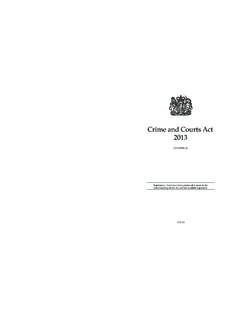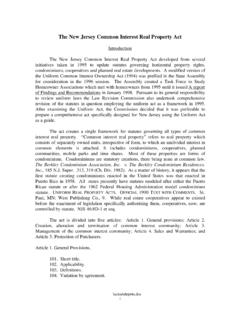Transcription of ARTICLE 4 DIRECTION – DELEGATED POWERS REPORT
1 ARTICLE 4 DIRECTION DELEGATED POWERS REPORT 1. SUMMARY The purpose of this REPORT is to set out the reasons for introducing an ARTICLE 4 DIRECTION to remove permitted development rights for change of use from Class C3 to Class C4 in the areas shown on the map in Appendix 2. It seeks the authority of the Executive Director of Place to make the ARTICLE 4 DIRECTION , which is attached in Appendix 1. 2. WHAT DOES THIS MEAN FOR SHEFFIELD PEOPLE? This ARTICLE 4 DIRECTION will mean that within the area shown on the map in Appendix 2 owners of residential properties who wish to use them for Houses in Multiple Occupation (Class C4) would need to apply for planning permission to do so. This means that the impact of new shared housing, in areas where there are already high concentrations, can be considered, and controlled if necessary. In turn this means that mixed communities are supported.
2 3. OUTCOMES AND SUSTAINABILITY The main objective of the ARTICLE 4 DIRECTION is to ensure that where opportunities arise, development can be prevented (through control of planning permission), which might contribute to communities becoming unsustainable as a result of a concentration of shared housing. The Council s Corporate Plan, A City of Opportunity , makes it clear that the Council prioritises stronger communities, which means cohesive communities where people from different backgrounds and of different generations get on well together, feel valued and feel they have a voice. This means that there should be a good mix of housing available, and high concentrations of shared housing which often results in a transitory population, should be discouraged. 4. BACKGROUND The Sheffield Development Framework Core Strategy, adopted in 2009, includes a policy about Creating Mixed Communities (CS41).
3 This policy was developed in order to limit new, or conversions to, hostels, purpose-built student accommodation and Houses in Multiple Occupation, where the community is already imbalanced by a concentration of such uses or where the development would create imbalance. At that time, it was only possible to apply the policy to planning applications for Houses in Multiple Occupation which fell outside the definition of C3 dwellinghouses, having 7 or more unrelated residents. In April 2010 the Government introduced a new use class, C4 Houses in Multiple Occupation to cover smaller shared houses, with a similar definition to the Housing Act (3 6 people sharing). This required landlords to seek - 1 - planning permission to convert a dwellinghouse into a House in Multiple Occupation. However, this was altered by the coalition Government on 1st October 2010. The two distinct uses are retained, but it is now within permitted development rights to convert a dwellinghouse for an HMO use.
4 Local Planning Authorities can make an ARTICLE 4 DIRECTION so that change of use by permitted development must require planning permission. In Sheffield, we would be able to use Core Strategy policy CS41 to then determine whether planning permission should be granted or not, on the basis of the concentration of shared housing in the area. From the date when the DIRECTION comes into force all changes of use from C3 to C4 in the area shown in Appendix 2 will require planning permission. The process for making this ARTICLE 4 DIRECTION is in accordance with current Government guidance. 5. JUSTIFICATION FOR INTRODUCING AN ARTICLE 4 DIRECTION Department for Communities and Local Government Circular 08/2010 highlights that a high concentration of shared homes can sometimes cause problems, especially if too many properties in one area are let to short term tenants with little stake in the local community.
5 This is why legislation has been put in place to allow local authorities to control high concentrations where there is a problem. Government guidance1 states that when deciding whether an ARTICLE 4 DIRECTION is appropriate, local planning authorities should identify the potential harm which it is intended to address. Specifically in relation to shared housing, planning authorities can consider whether the exercise of permitted development rights would undermine local objectives to create or maintain mixed communities. The adopted Core Strategy contains policy CS41 which seeks to support creation of mixed communities. Community groups in areas with high percentages of shared housing supported the approach taken in the Core Strategy policy CS41, and welcomed changes to introduce use class C4. This ARTICLE 4 DIRECTION adds weight to policy CS41 and therefore will help support the objective of creating more mixed communities in areas where there is currently imbalance.
6 In some areas of Sheffield, private rented shared housing makes up a significant proportion of the housing stock, which has led to the argument that communities are no longer mixed, and therefore not sustainable. Such housing is characterised by a younger, more transient population and this affects community stability. Core Strategy policy CS41 seeks to restrain further shared housing where there are already high concentrations in a 1 Department for Communities and Local Government Replacement Appendix D to Department of the Environment Circular 9/95: General Development Consolidation Order 95, paragraph - 2 - community, and the ARTICLE 4 DIRECTION will add considerable strength to this, by enabling planning control over smaller shared houses. It is estimated that there are currently in excess of 50,000 students studying at the city s two universities, many of whom live in non-university owned accommodation, putting strain on private housing around the two universities.
7 The main concerns relating to the effects of concentrations of student housing on communities, issues raised by communities in these areas have included; anti-social behaviour, problems with parking, poor management of housing stock, balance of communities and the loss of population outside term time. In addition to this, evidence of increasing affordability and mortgage borrowing problems is likely to mean that young people remain in the private rented sector for longer rather than going into home ownership. In many cases this will be in shared housing the same as that used by students with similar implications where there is an over-concentration. Implementation of this ARTICLE 4 DIRECTION would not prevent all development of HMOs within its boundary. Rather, by requiring planning permission for conversions of dwelling houses to HMOs it enables the Council to assess whether the development is in an area with a concentration of shared housing, and whether it would create or increase imbalance.
8 6. BOUNDARY FOR THE ARTICLE 4 DIRECTION The boundary for the ARTICLE 4 DIRECTION has been drawn using evidence about known locations of shared housing from the Private Rented Sector Housing Team. Although there is shared housing in many parts of the city, this is generally at a low level, with some distinct areas having a significant level of shared housing. A clear pattern is revealed by analysis of the data, which shows that areas where communities perceive a concentration of shared housing are significantly above the level of shared housing displayed in other areas. We decided not to draw a boundary which covers the whole local planning authority area as this would result in permitted development rights being removed in many areas where there are no issues with concentrations of shared housing. The proposed boundary is based on 'Medium Super Output Area' (MSOA) and Lower Super Output Area (LSOA) boundaries.
9 These are statistical geographical areas published by the Office for National Statistics, and used nationally as the basis for small area statistics (for example in the census). Nationally they are of similar population size, unlike for example electoral wards. There are 71 MSOA areas and 339 LSOA areas in Sheffield, which means we can use them for a more fine-grained boundary than larger areas such as wards or Community Assembly areas. In the area proposed for the ARTICLE 4 DIRECTION , the concentration of shared housing as a proportion of residential properties is 10% or higher. This means that it includes all those - 3 - areas where Core Strategy policy CS41 would enable control over further development of HMOs due to high (over 20%) concentrations of shared housing. However, it excludes areas where concentrations are lower and where it would be excessive to require planning permission for HMO development as it would almost certainly be granted, and would simply add a burden to landlords in those areas.
10 The proposed boundary includes areas around the two universities and in the south-western suburbs, where there are high levels of housing shared by students or other groups such as young professionals. There is a risk that landlords wishing to develop further Houses in Multiple Occupation would look instead to properties outside the ARTICLE 4 DIRECTION boundary. However, the majority of areas outside the boundary are likely to be too far away from the City Centre, universities and some hospitals to be considerably attractive for shared housing. The pattern of concentrations of shared housing is kept under review, and if there is need for amendment then a further ARTICLE 4 DIRECTION could be made if necessary. 7. PROCEDURE This REPORT formally makes the ARTICLE 4 DIRECTION attached in Appendix 1. Sheffield City Council will give notice of the DIRECTION and representations will be sought in accordance with the Town and Country Planning (General Permitted Development) Order 1995, as amended.








